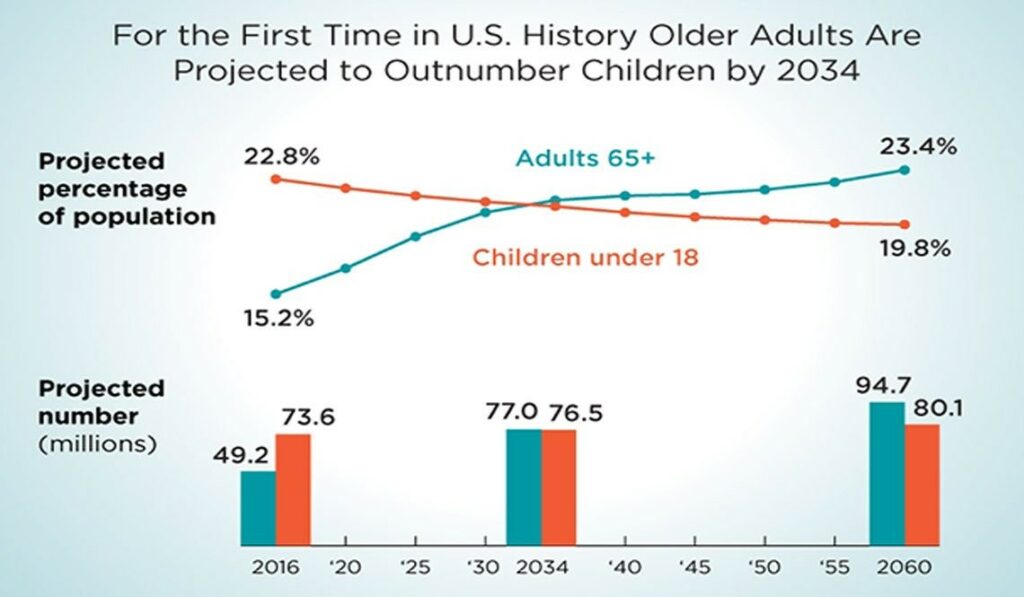In 1991, the United Nations (UN) adopted October 1 as the International Day of Older Persons. According to the UN’s webpage on international observances, “By creating special observances, the United Nations promotes international awareness and action on these issues…International days are occasions to educate the general public on issues of concern, to mobilize political will and resources to address global problems, and to celebrate and reinforce achievements of humanity.”
The UN article brings out an important statistic about population aging:
Over the next three decades, the number of older persons worldwide is projected to more than double, reaching more than 1.5 billion persons in 2050.
Coupled with that statistic, the Who Health Organization (WHO) in their overview of their 2019 World Vision Report stated that, “At present at least 2.2 billion people around the world have a vision impairment, of whom at least 1 billion have a vision impairment that could have been prevented or is yet to be addressed.”
Further, the COVID-19 pandemic has highlighted the seriousness of existing gaps in policies, systems, and services throughout the world.
With this information in mind, the UN has designated 2021-2030 as the Decade of Healthy Aging, citing that, “A decade of concerted global action on healthy aging is urgently needed to ensure that older people can fulfill their potential in dignity and equality and in a healthy environment.” Further WHO has completed a Baseline Report for the Decade of Healthy Aging that will serve as a benchmark.
Decade of Healthy Aging Action Areas
- Age Friendly Environments
- Combating Ageism
- Integrated Care
- Long Term Care
How Do These Action Areas Impact on Aging and Vision Loss in the United States?
 An Aging Nation Census Bureau Chart
An Aging Nation Census Bureau Chart
According to the Census Bureau, by 2034, the United States will be comprised of more older adults than of children and there will be 77 million people age 65 and over compared to 76.5 million under the age of 18. The number of people with vision loss, too, is scheduled to double by 2050, tracking the aging trajectory of the population.
All of the Action Areas have significance for older people with vision loss. In this post, we will discuss age-friendly environments and integrated care.
Age-Friendly Environments
In this country, AARP has made a major push for age-friendly environments through its Age Friendly Community Initiative, modeled after the World Health Organization’s Global Network for Age Friendly Communities. A major concern for AARP is the livability of communities for people of all ages and what that entails, asking if we are prepared for this major increase in the number of older people. AARP helps communities examine their housing, transportation and access needs through an age-friendly lens and has developed a livability index to gauge how communities measure up.
Lack of transportation is a known issue for people with vision loss in general, and the pandemic has greatly increased the problem and the potential of social isolation. But there are lots of other aspects of livability that should be considered among them wayfinding, signage, texture, use of color and contrast in the environment, and lighting. With all these facts in mind, it is important that older people with vision loss become aware of and engaged with this initiative and give voice to your concerns. AARP is hosting a Livable Communities Workshop on September 22 and 23. The event is free and just requires registration.
Integrated Care
The World Health Organization (WHO) has developed the Integrated Care for Older People (ICOPE) approach to help health and social care systems to effectively respond to the diverse and complex needs of older people. These systems include rehabilitation.
According to WHO’s Integrated care for older people (ICOPE) implementation framework: guidance for systems and services publication, the “ICOPE Implementation Framework provides guidance for policymakers and program managers to concretely assess and measure the capacity of services and systems to deliver integrated care at the community level.” This is an approach that we seem to lack in this country, and we see every day that older people with vision loss literally “fall” between the cracks of the health, social service, aging, and rehabilitation systems with only 3% of older people with vision loss receiving vision rehabilitation services. The ICOPE framework “provides a scorecard to help assess the overall capacity of health and social care services and systems to deliver integrated care in community settings.”
There are nineteen parts to the scorecard; two parts specifically mention older people with vision loss:
- Make available the infrastructure (e.g., physical space, transport, telecommunications) that is needed to support safe and effective care delivery in the community, e.g., providing accessible information for people with hearing loss and/or visual impairment. (p. 23)
- Deliver care (with assistive products when needed) that is acceptable to older people and targets functional ability (FA) such as providing assistive products that can accommodate losses in intrinsic capacity (IC) and so maintain FA. Examples include spectacles, hearing aids and mobility aids.] (p. 24)
However, if effective integrated services are to be provided, all nineteen parts of the ICOPE approach are essential.
ICOPE states, “Local leadership, to drive implementation efforts that integrate services effectively, is needed at both system and service levels.” (p. 5)
Find out what is happening in the U.S. to address vision rehabilitation and aging, read about the National Coalition on Aging and Vision Loss.
Your voice is needed locally, at state levels and at the national level to take note of these action areas and how to plug into this important national and global work and make a difference.
Help make the International Day of Older People really mean something in your community starting on October 1.
Aging and Vision Loss National Coalition
Video About the Decade of Healthy Aging as it Relates to the Americas. Includes link to find out more.